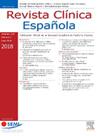La amiloidosis cardiaca empeora el pronóstico en los pacientes con insuficiencia cardiaca: hallazgos del estudio PREVAMIC
IF 1.7
4区 医学
Q2 MEDICINE, GENERAL & INTERNAL
引用次数: 0
Abstract
Background and objectives
Cardiac amyloidosis (CA) is a common pathology in elderly patients that usually presents as heart failure (HF). However, it is not clear whether CA associated with HF has a worse prognosis compared with HF due to other etiologies.
Material and methods
Prospective, observational cohort study that recruited patients ≥65 years of age with HF in 30 Spanish centers. The cohort was divided according to whether the patients had AC or not. Patients were followed for 1 year.
Results
A total of 484 patients were included in the analysis. The population was elderly (median 86 years) and 49% were women CA was present in 23.8% of the included patients. In the CA group, there was a lower prevalence of diabetes mellitus and valvular disease. At one year of follow-up, mortality was significantly more frequent in patients with CA compared to those without (33.0 vs.14.9%, p < 0.001). However, there were no differences between both groups in visits to the emergency room or readmissions. In the multivariate analysis, the variables that were shown to predict all-cause mortality at one year of follow-up were chronic kidney disease (HR 1.75 (1.01-3.05) p = 0.045), NT-proBNP levels (HR 2.51 (1.46-4.30) p < 0.001), confusion (HR 2.05 (1.01-4.17), p = 0.048), and the presence of CA (HR 1.77 (1.11-2.84), p = 0.017).
Conclusion
The presence of CA in elderly patients with HF is related to a worse prognosis at one year of follow-up. Early diagnosis of the pathology and multidisciplinary management can help improve patient outcomes.
心脏淀粉样变性会加重心力衰竭患者的预后:PREVAMIC 研究的发现
背景和目的心脏淀粉样变性(CA)是老年患者的一种常见病症,通常表现为心力衰竭(HF)。然而,与其他病因引起的心力衰竭相比,与心力衰竭相关的心脏淀粉样变性是否预后更差,目前尚不清楚。根据患者是否患有交流性心脏病对队列进行了划分。结果 共有 484 名患者纳入分析。研究对象为老年人(中位数为 86 岁),49% 为女性,23.8% 的患者患有冠心病。在CA组中,糖尿病和瓣膜病的发病率较低。随访一年后,CA患者的死亡率明显高于非CA患者(33.0% vs.14.9%, p <0.001)。不过,两组患者在急诊就诊和再入院方面没有差异。在多变量分析中,可预测随访一年后全因死亡率的变量是慢性肾病(HR 1.75 (1.01-3.05) p = 0.045)、NT-proBNP 水平(HR 2.51 (1.46-4.30) p < 0.001)、精神错乱(HR 2.05 (1.01-4.17),p = 0.048)和CA的存在(HR 1.77 (1.11-2.84),p = 0.017)。早期病理诊断和多学科治疗有助于改善患者的预后。
本文章由计算机程序翻译,如有差异,请以英文原文为准。
求助全文
约1分钟内获得全文
求助全文
来源期刊

Revista clinica espanola
医学-医学:内科
CiteScore
4.40
自引率
6.90%
发文量
73
审稿时长
28 days
期刊介绍:
Revista Clínica Española published its first issue in 1940 and is the body of expression of the Spanish Society of Internal Medicine (SEMI).
The journal fully endorses the goals of updating knowledge and facilitating the acquisition of key developments in internal medicine applied to clinical practice. Revista Clínica Española is subject to a thorough double blind review of the received articles written in Spanish or English. Nine issues are published each year, including mostly originals, reviews and consensus documents.
 求助内容:
求助内容: 应助结果提醒方式:
应助结果提醒方式:


